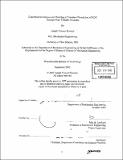| dc.contributor.advisor | John H. Lienhard. | en_US |
| dc.contributor.author | Romero, Joseph Vincent, 1977- | en_US |
| dc.contributor.other | Massachusetts Institute of Technology. Dept. of Mechanical Engineering. | en_US |
| dc.date.accessioned | 2006-03-24T18:06:26Z | |
| dc.date.available | 2006-03-24T18:06:26Z | |
| dc.date.copyright | 2003 | en_US |
| dc.date.issued | 2003 | en_US |
| dc.identifier.uri | http://hdl.handle.net/1721.1/29957 | |
| dc.description | Thesis (S.M.)--Massachusetts Institute of Technology, Dept. of Mechanical Engineering, 2003. | en_US |
| dc.description | Includes bibliographical references (leaves 79-80). | en_US |
| dc.description.abstract | A simulation study was performed to model the transient behavior of the dissolution of hexahydro-1, 3,5-trinitro-1, 3,5-triazine (RDX) in Composition B. Composition B, also referred to as CompB. CompB is made up of three parts: 54% RDX, 6% HMX and 40% TNT. A numerical simulation was employed to model the overall solute transport equation. The solute transport equation takes into account advection, dispersion, sorption, degradation, mobile-immobile sorption, and a mass transfer source term. Numerical code was developed and this model simulated the following: (1) flow rate, (2) initial mass loading, (3) particle size and (4) field oil. The simulation model results verified laboratory experiments provided by Phelan et. al. [2003] by applying the governing advection-dispersion equation with a linear-driving-force source term of the form kf (C, - C) . The variable k represents the lumped mass transfer coefficient [1/day], which implicitly incorporates specific surface area. The concentration denoted as C [mg/L], represents the effluent chemical concentration present in water at a given time while C, [mg/L] represents the concentration at equilibrium. The mass transfer source term was evaluated by correlating k to the modified Sherwood number. The modified Sherwood number was fitted with a least-squares method that approximated non-aqueous phase liquid (NAPL) dissolution [Miller et. al., 1990]. This study adjusted the constants developed with the obtained modified Sherwood number to model RDX. Modeling development used a modified Sherwood number in the form: ... The simulation code effectively modeled RDX effluent profiles. | en_US |
| dc.description.statementofresponsibility | by Joseph Vincent Romero. | en_US |
| dc.format.extent | 80 leaves | en_US |
| dc.format.extent | 3033599 bytes | |
| dc.format.extent | 5225280 bytes | |
| dc.format.mimetype | application/pdf | |
| dc.format.mimetype | application/pdf | |
| dc.language.iso | eng | en_US |
| dc.publisher | Massachusetts Institute of Technology | en_US |
| dc.rights | M.I.T. theses are protected by copyright. They may be viewed from this source for any purpose, but reproduction or distribution in any format is prohibited without written permission. See provided URL for inquiries about permission. | en_US |
| dc.rights.uri | http://dspace.mit.edu/handle/1721.1/7582 | |
| dc.subject | Mechanical Engineering. | en_US |
| dc.title | Experimental analysis and modeling of transient dissolution of RDX through mass transfer processes | en_US |
| dc.type | Thesis | en_US |
| dc.description.degree | S.M. | en_US |
| dc.contributor.department | Massachusetts Institute of Technology. Department of Mechanical Engineering | |
| dc.identifier.oclc | 54628552 | en_US |
